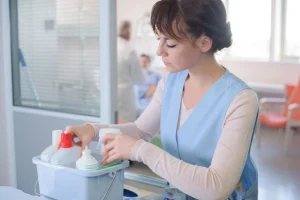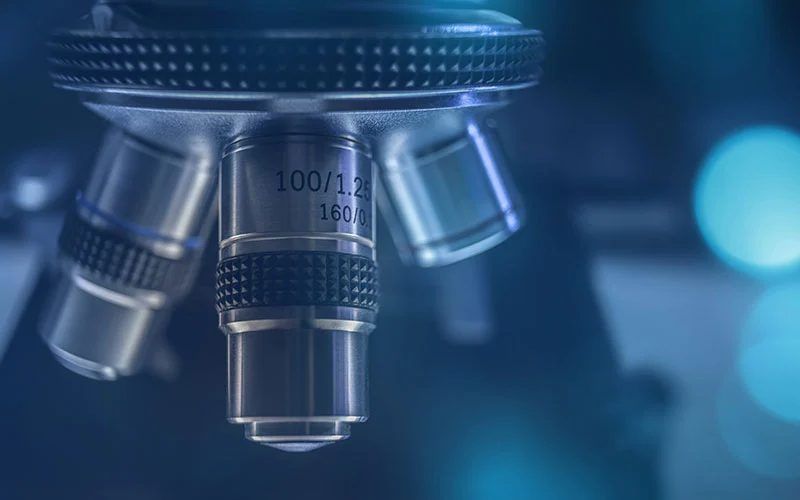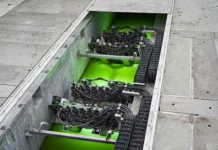Robert A. Garcia, BS, MT(ASCP), CIC, FAPIC
Article excerpt reprinted courtesy of CASPR Medik™
The development of healthcare-associated infections (HAIs) remains a major national patient safety issue, with upward of 1.7 million infections and 99,000 deaths occurring annually. The overall direct cost of HAIs to hospitals has been reported to be in the range from $28 billion to $45 billion1.
Recent analysis of data from the Agency for Healthcare Research and Quality (AHRQ) indicates that facilities incur increased costs ranging from 47% to 70% for medical harms, such as catheter-related bloodstream infections (CRBSIs) and catheter-associated urinary tract infections (CAUTI) when patient re-admissions are considered2.
Pathogen transmission
The routes of transmission of nosocomial pathogens in healthcare settings have been well researched3. Patients colonized or infected with pathogens may:
- shed organisms onto their skin, bedding or clothing, such as gowns
- contaminate nearby environmental surfaces
- contaminate portable equipment used in their care
The available evidence suggests that pathogen transfer occurs frequently. Wolfensberger and colleagues’ recent review of the published literature indicates transfer frequencies of pathogens from patients and their environment to healthcare provider (HCP) hands, gloves and gowns are 33%, 30% and 10%, respectively. HCP behaviors that only entailed contact with an environmental source led to transfer frequencies > 40% for such pathogens as methicillin-resistant Staphylococcus aureus (MRSA), vancomycin-resistant Enterococcus (VRE), and Clostridium difficile4.
One recent study underscores the potential for patient shedding of pathogens onto their hospital gowns which, in turn, may act as sources for further transmission onto fomites. Researchers examined the burden of MRSA on multiple areas of clothing worn by patient carriers, including at the neck, chest, waistline, sleeve cuffs and pockets. MRSA was recovered from 74% of sampled gown sites.
Further assessment was made as to the potential for transfer of the organism from the clothing of MRSA carriers to HCP gloves. MRSA transfer occurred 62% of the time when fingertips of sterile gloves were contacted with contaminated areas of clothing of identified carriers. When MRSA carriers were placed in wheelchairs, 50% of 10 carriers transferred MRSA to a wheelchair surface within 20 minutes5.
An estimated 20% to 40% of HAIs are attributed to cross-infection from organisms on the hands of healthcare personnel6. Contamination of the hands of HCPs results from direct contact with a colonized or infected patient or from contaminated fomites – hands thus serving as the vector to additional surfaces or to a new susceptible patient. The hands of HCPs are just as likely to be contaminated by touching an environmental source as would be by direct contact with a patient7. The risk of further pathogen transfer increases knowing that observations have noted that HCPs wash their hands to lesser degrees after contact with a patient’s environment than when directly contacting the patient8.
Advanced technologies
Hospitals are increasingly investigating alternative solutions to supplement traditional practices in disinfection of the patient environment due to failures associated with achieving thorough patient room cleaning, whether due to inadequate or overlooked cleaning of objects, lack of proper supervision and monitoring, lack of resources, low levels of hand hygiene or other factors. Among these new technologies are antimicrobial coatings of surfaces and use of ultraviolet light (UV) or hydrogen peroxide vapors or aerosolization.
UV-C/HP background
Among the best studied of new “no touch” room disinfection technologies are mobile robots that incorporate the automated emission of chemical vapors, aerosols or UV. Chemical vapor and aerosolizing technology use hydrogen peroxide as the primary disinfecting agent. The majority of UV or hydrogen peroxide (HP) systems provide the technology using a portable machine that is set up in the patient’s room as per the individual manufacturer’s instructions.
UV-C
UV irradiation eradicates organisms by breaking the molecular bonds in DNA. Systems using UV-C produce wavelengths between 200 to 270 nm, a zone which lies in the known germicidal range of the electromagnetic spectrum (200 to 320 nm). A second UV device that uses pulse xenon technology (UV-X) also is widely available. Such factors as organic load, pathogen type, intensity, surface types, distance of the surface from the device, placement of the machine in the room, exposure time, room size and configuration, and air movements contribute to the efficacy of UV46.
Weber and colleagues provide insight on nine studies assessing the efficacy of UV irradiation in reducing microbial loads on intentionally contaminated environmental surfaces34. Several important points can be deduced from these results:
- Use of UV for 15 to 20 minutes achieved a > 3-log10 reduction in vegetative bacteria, including MRSA, VRE and Acinetobacter baumanii.
- C. difficile spores also are decreased by > 3-log10 as seen with other vegetative bacteria but require extended UV treatment times of 35 to 100 minutes.
- Increasing the distance from the device reduced the killing efficacy for MRSA, VRE and C. difficile.
- The effectiveness of UV was reduced when the surface was not in the direct line of sight of the UV emission.
- Spreading the inoculum over a wider area increased the ability to kill the organisms47-51.
Manufacturers recommend that facilities using UV may need supplemental room treatments after the initial decontamination cycle. This would entail repositioning the mobile unit with consideration of surfaces that may not have had direct line-of-site exposure during the first decontamination cycle, including adjoining or opposite surfaces of bed rails, furnishings and equipment52, rolling or stationary computers, along with accessories like keyboards and mice53, as well as the surfaces of adjoining bathrooms54,55. The importance of providing optimal line-of-site positioning during UV decontamination becomes clearer when light intensity is considered. A simulation trial in which the researchers coated the walls of test rooms with reflective paint resulted in enhanced intensity of ultraviolet light on indirect surfaces in the trial rooms and, in turn, was associated with significant log-10 reductions of both MRSA and C. difficile test organisms56. Several trials have examined the effectiveness of UV-C devices on decontaminating patient rooms after patient discharge.
In nine published studies using either UV-C or ultraviolet pulsed xenon devices (UV-PX), pathogens such as MRSA, VRE and Acinetobacter spp. were reduced in 1,025 minutes, with three studies using two to three cycles. C. difficile cycle times ranged from 10 to 45 minutes. The frequency of positive surface sites post-treatment was <11%, while log-10 reductions were all reported as two or less42.
The first randomized clinical trial to assess a UV-C no-touch technology is the Benefits of Enhanced Terminal Room Disinfection (BETR-D) study, the results of which were published in 201757. This crossover trial conducted at nine hospitals examined three strategies for enhanced room decontamination: use of a quaternary ammonium compound plus UV-C, bleach only or bleach plus UV-C. Treated rooms were those that housed a patient identified with MRSA, VRE or C. difficile. Outcomes measured included subsequently admitted patients acquiring an HAI with one of the target pathogens. Both hand hygiene and terminal room cleaning measurement compliance showed no differences at baseline or among the three study groups.
The study concluded that the addition of a UV-C device to the standard disinfection strategy during terminal decontamination decreased the acquisition of a target organism by approximately 10% to 30%, suggesting that the environment is responsible for a significant portion of MDRO acquisition23.
No significant differences were found in the incident rates of target organisms when using bleach or bleach plus UV-C when compared to use of a quaternary ammonium compound alone. Insights provided by the authors of the BETR-D study on implementation challenges encountered with UV-C devices indicated the need to overcome two key barriers: establishing priorities for room selection and overcoming time constraints to allow environmental staff sufficient time to employ the enhanced terminal disinfection method prior to admission of the next patient58. In this study, the assigned hospital staff required an additional 10 to 20 minutes for each enhanced terminal disinfection strategy for rooms in which patients were to be admitted from an emergency room. Furthermore, use of the UV-C device was limited to only 60% of “seed” rooms59.
Continuous full facility decontamination
 Understanding the evolution and the principle designs of environmental disinfecting technology and, most importantly, the limitations inherent in the methods of operation, has led science to the next level in decontamination concept. Research engineers have designed a continuous disinfection technology using a natural catalytic converter inserted into the ducts of an HVAC system. This new device converts H2O and O2 in the air into hydrogen peroxide (H2O2). The device uses a multi-wavelength ultraviolet light to illuminate target surfaces consisting of a honeycomb matrix treated with photocatalytic coating consisting of titanium oxide (TiO2) and other reactive metals added to enhance the overall catalytic effect.
Understanding the evolution and the principle designs of environmental disinfecting technology and, most importantly, the limitations inherent in the methods of operation, has led science to the next level in decontamination concept. Research engineers have designed a continuous disinfection technology using a natural catalytic converter inserted into the ducts of an HVAC system. This new device converts H2O and O2 in the air into hydrogen peroxide (H2O2). The device uses a multi-wavelength ultraviolet light to illuminate target surfaces consisting of a honeycomb matrix treated with photocatalytic coating consisting of titanium oxide (TiO2) and other reactive metals added to enhance the overall catalytic effect.
When inserted into the ducts of the HVAC system, the device reacts with water molecules in humidity to continuously create predominantly H2O2 molecules, which exit the duct and disperse throughout the targeted area, safely covering the surfaces of occupied rooms and patient care areas with effective oxidizing molecules that work to reduce the bioburden of clinically relevant pathogens.
Studies currently being conducted using continuous natural catalytic converter decontamination in hospital patient rooms have indicated an average reduction in environmental microburden of between eight and 10-fold as compared to pre-activation baseline samples documented through environmental sampling of high-touch points. Independent clinical studies of the effectiveness of the continuous disinfection technologies have shown at least a >3-log-10 reduction in clinically relevant pathogens associated with environmental contamination (unpublished data).
One added benefit of the technology demonstrated in the hospital trials is the impact on HCP absenteeism. In one trial in a large 527-bed hospital, the technology was employed to treat the entire area of the ICU, including patient rooms, nurse stations and work areas. Absenteeism rates were reduced to 752 hours during a four-month period from 1,316 hours for the same period during the previous year. The decrease represented a 42% reduction and represented a gain of over 80% of an FTE.
Conclusion
Environmental contamination of hospital patient rooms poses a significant risk for the subsequent transfer of pathogens and development of hospital-acquired infections. “No-touch” room decontamination technologies have evolved to address this issue using methodologies that have been well studied.
However, mobile technologies have limitations that have been reported in the scientific literature. A newly designed device that delivers continuous decontamination effect using a natural catalytic conversion technology built into HVAC systems has demonstrated preliminary positive results in reducing environmental contamination with pathogens.
The technology is the first disinfection solution that is practical to employ throughout an entire facility to address not just highly contaminated patient rooms but all patient rooms, nurse stations, public areas, floors and work areas.
CASPR Medik™ has all of the benefits of a robot with the enhanced ability to cover the entire environment of care, continuously. The natural catalytic converter solution is quickly and easily installed throughout the ductwork of existing HVAC system, where it provides continuous facility-wide surface protection. CASPR works on its own, without an operator or any human interaction, providing effortless supplemental protection for all surfaces throughout the environment of care. The disinfection technology is proven effective against relevant pathogens and has been linked to reduced HAIs. To view the full article, including references, visit CASPRgroup.com.
References
- Stone P. Economic burden of healthcare-associated infections: an American perspective. Expert Rev Pharmacoecon Outcomes Res 2009;9:417-22.
- Anand P, Kranker K, Chen AY. Estimating the hospital costs of inpatient harms. Health Serv Res 2018; 1-11.
- Donskey CJ. Does improving surface cleaning and disinfection reduce health care-associated infections? AJIC 2013;41:S12-S19.
- Wolfensberger A, Clack L, Kuster SP, Passerini S, Mody L, et al. Transfer of pathogens to and from patients, healthcare providers, and medical devices during care activity – a systematic review and meta-analysis. Infect Control Hosp Epidemiol 2018;39:1093-1107.
- Kanwar A, Cadnum JL, Thakur M, Jencson BS, Donskey CJ. Contaminated clothing of methicillinresistant Staphylococcus aureus (MRSA) carriers is a potential source of transmission. Am J Infect Control 2018;46:1414-
- Weinstein RA. Epidemiology and control of nosocomial infections in adult intensive care units. Am J Med 1991;9 (Supp3B):S179-S184.
- Stiefel U, Cadnum JL, Eckstein BC, Guerrero DM, Tima MA, et al. Contamination of hands with methicillinresistant Staphylococcus aureus after contact with the skin of colonized patients. Infect Control Hosp Epidemiol 2011;32:185-7.
- Randle J, Arthur A, Vaughn N. Twenty-four hour observational study of hospital hand hygiene compliance. J Hosp Infect 2010;76:252-5.
- Suleyman G, Alangaden G, Bardossy AC. The role of the environmental contamination in the transmission of nosocomial pathogens and healthcare-associated infections. Curr Infections Dis Rep 2018;20:11-12.
- Dancer SJ. The role of environmental cleaning in the control of hospital acquired infection. J Hosp Infect 2009;73:378-85.
- Boyce JM. Environmental contamination makes an important contribution to hospital infection. J Hosp Infect 2007;65:50-4.
- Weber DJ, Rutala WA, Miller MB, Huslage K, SickbertBennett E. Role of hospital surfaces in the transmission of emerging health care-associated pathogens: Norovirus, Clostridium difficile, and Acinetobacter species. Am J Infect Control 2010;38:S25-33.
- Wille I, Mayr A, Kreidl P, Bruhwasser C, Hintererger G, et al. Cross-sectional point prevalence survey to study the environmental contamination of nosocomial pathogens in intensive care units under real-life conditions. J Hosp Infect 2018;98:90-5.5.
- Rashid T, Vonville H, Hasan I, Garey KW. Mechanisms for floor surfaces or environmental ground contamination to cause human infection: a systematic review. Epidemiol Infect 2017;145:347-57.
- Deshpande A, Cadnum JL, Fertelli D, Sitzler B, Thota P, et al. Are hospital floors an underappreciated reservoir for transmission of health care-associated pathogens? Am J Infect Control 2017;45:336-38.
- Shek K, Patidar R, Kohja Z, Liu S, Gawaziuk JP, Gawthrop M, et al. Rate of contamination of hospital privacy curtains in a burns/plastic ward: a longitudinal study. Am J Infect Control 2018;46:1019-21.
- Haun N, Hooper-Lane C, Safdar N. Healthcare personnel attire and devices as fomites: a systematic review. Infect Control Hosp Epidemiol 2016;37:1367-73.
- Kramer A, Schwebke I, Kampf G. How long do nosocomial pathogens persist on inanimate surfaces? A systematic review. BMC Infect Dis 2006;6:130.
- Piedrahita C, Cadnum JL, Jencson AL, Shaikh AA, Ghannoum MA, et al. Environmental surfaces in healthcare facilities are a potential source for transmission of Candida auris and other Candida species. Infect Control Hosp Epidemiol 2017;38:1107-9.
- Huang SS, Datta R, Platt R. Risk of acquiring antibioticresistant bacteria from prior room occupants. Arch Int Med 2006;166:1945-51.
- Otter JA. The role played by contaminated surfaces in the transmission of nosocomial pathogens. Infect Control Hosp Epidemiol 2011;32:687-99.
- Cohen B, Liu J, Cohen AR, Larson E. Association between healthcare-associated infection and exposure to hospital roommates and previous bed occupants with the same organism. Infect Control Hosp Epidemiol 2018;39:541-46.
- Chen LF, Knelson LP, Gergen MF, Bteer OM, Nicholson BP, et al. A prospective study of transmission of multidrug-resistant organisms (MDROs) between environmental sites and hospitalized patients – the TransFER study. Infect Control Hosp Epidemiol 2018;40:47-52.
- Carling PC, Parry MF, Von Beheren SM. Healthcare Environmental Hygiene Study Group. Identifying opportunities to enhance environmental cleaning in 23 acute care hospitals. Infect Control Hosp Epidemiol 2008;29:1-7.
- Carling PC, von Bheren S, Kim P, Woods C. Intensive care unit environmental cleaning: an evaluation in sixteen hospitals using a novel assessment tool. J Hosp Infect 2008;68:39-44.
- Shams AM, Rose LJ, Edwards JR, Cali S, Harris AD, et al. Assessment of the overall and multidrug-resistant organism bioburden on environmental surfaces in healthcare facilities. Infect Control Hosp Epidemiol 2016;37:1426-32.
- Zoutman DE, Ford BD, Sophia K. Environmental cleaning resources and activities in Canadian acute care hospitals. Am J Infect Control 2014;42:490-4.
- Doll M, Stevens M, Bearman G. Environmental cleaning and disinfection of patient areas. Int J Infect Dis 2018;67:52-7.
- Boyce JM. Modern technologies for improving cleaning and disinfection of environmental surfaces in hospitals. Antimicrob Resistance Infect Control 2016;5:1-10.
- Hota B, Blom DW, Lyle EA, Weinstein RA, Hayden MK. Intervention evaluation of environmental contamination by vancomycin-resistant enterococci: failure of personnel, product, or procedure? J Hosp Infect 2009;71:123-31.
- Goodman ER, Platt R, Bass R, Onderdonk AB, Yokoe DS, et al. Impact of an environmental cleaning intervention on the presence of methicillin-resistant Staphylococcus aureus and vancomycin-resistant enterococci on surfaces in intensive care unit rooms. Infect Control Hosp Epidemiol 2008;29:593-9.
- Carling PC, Parry MF, Bruno-Murtha AL, Dick B. Improving environmental hygiene in 27 intensive care units to decrease multidrug-resistant bacterial transmission. Crit Care Med 2010;38:1054-9.
- Carling PC, Parry MF, Rupp ME, Po JL, Dick B, et al. Healthcare Environmental Hygiene Study Group, et al. Improving cleaning of the environment surrounding patients in 36 acute care hospitals. Infect Control Hosp Epidemiol 2008;29:1035-41.
- Weber DJ, Rutala WA, Anderson DJ, Chen LF, SickertBennett EE, et al. Effectiveness of ultraviolet devices and hydrogen peroxide systems for terminal room decontamination: focus on clinical trials. Am J Infect Control 2016;44:77-84.
- Eckstein BC, Adams DA, Eckstein EC, Rao A, Sethi AK, et al. Reduction of Clostridium difficile and vancomycin-resistant Enterococcus contamination of environmental surfaces after an intervention to improve cleaning methods. BMC Infect Dis 2007;7:61.
- Ray AJ, Deshpande A, Fertelli D, Sitzlar BM, Thota P, et al. A multicenter randomized trial to determine the effect of an environmental disinfection intervention on the incidence of healthcare-associated Clostridium difficile infection. Infect Control Hosp Epidemiol 2017;38:777-83.
- Snyder GM, Holyoak AD, Leary KE, Sullivan BF, Davis RB, et al. Effectiveness of visual inspection compared with non-microbiologic methods to determine the thoroughness of post-discharge cleaning. Antimicrob Resist Infect Control 2013;2:26.
- Knelson LP, Ramadanovic GK, Chen LF, Moehring RW, Lewis SS, et al. Self-monitoring by environmental services may not accurately measure thoroughness of hospital room cleaning. Infect Control Hosp Epidemiol 2017;38:1371-2.
- Huslage K, Rutala WA, Gergen MF, Sickbert-Bennett EE, Weber DJ. Microbial assessment of high, medium, and low-touch hospital room surfaces. Infect Control Hosp Epidemiol 2013;34:211-2.
- Karpanen TJ, Casey AL, Lambert PA, Cookson BD. The antimicrobial efficacy of copper alloy furnishing in the clinical environment: a crossover study. Infect Control Hosp Epidemiology 2012;33:3-9.
- Schmidt MG, Attaway HH, Sharpe PA, Joseph J, Sepkowitz KA, et al. Sustained reduction of microbial burden on common hospital surfaces through introduction of copper. J Clin Microbiol 2012;50:2217- 23.
- Weber DJ, Rutala WA. Self-disinfecting surfaces: review of current methodologies and future prospects. Am J Infect Control. 2013;41:S31–5.
- Souli NM, Antoniadon A, Katsarolis I, Mavrou I, Paramythiotou E, et al. Reduction of environmental contamination with multidrug-resistant bacteria by copper-alloy coating of surfaces in a highly endemic setting. Infect Control Hosp Epidemiol 2017;38:765-71.
- Rivero P, Brenner P, Nercelles P. Impact of copper in the reduction of hospital-acquired infections, mortality and antimicrobial costs in the adult intensive care unit. Rev Chilena Infectol 2014;31:274-9.
- Salgado CD, Sepkowitz KA, John JF, Cantey JR, Attaway HH, et al. Copper surfaces reduce the rate of healthcare-acquired infections in the intensive care unit. Infect Control Hosp Epidemiol 2013;34:479–86
- Rutala WA, Weber DJ. Disinfectants used for environmental disinfection and new room decontamination technology. Am J Infect Control 2013;41:526-41.
- Rutala WA, Gergen MF, Weber DJ. Room decontamination by ultraviolet radiation. Infect Control Hosp Epidemiol 2010;31:1025-9.
- Boyce JM, Havill NL, Moore BA. Terminal decontamination of patient rooms using an automated mobile UV light unit. Infect Control Hosp Epidemiol 2011; 32:743-7.
- Nerandzic MM, Cadnum JL, Pultz MJ, Donskey CJ. Evaluation of an automated ultraviolet radiation device for decontamination of Clostridium difficile and other healthcare-associated pathogens in hospital rooms. BMC Infect Dis 2010; 10:197.
- Cadnum JL, Tomas ME, Sanker T, et al. Effect of variation in test methods on performance of ultraviolet-C radiation room decontamination. Infect Control Hosp Epidemiol 2016;37:555-60.
- Boyce JM, Farrel PA, Towle D, et al. Impact of room location on UV-C irradiance and UV-C dosage and antimicrobial effect delivered by a mobile UV-C light device. Infect Control Hosp Epidemiol 2016;37:667-72.
- Kanamori H, Rutala WA, Gergen MF, Weber DJ. Patient room decontamination against carbapenemresistant Enterobacteriaceae and methicillin-resistant Staphylococcus aureus using a fixed cycle-time ultraviolet-C device and two different radiation designs. Infect Control Hosp Epidemiol 2016;37:994-6.
- Shaikh AA, Ely D, Cadnum JL, Koganti S, Alhmidi H, et al. Evaluation of low-intensity ultraviolet-C radiation device for decontamination of computer keyboards. Am J Infect Control 2016;44:705-7.
- Cooper J, Bryce E, Astrakianakis G, Stefanovic A, Bartlett K. Efficacy of an automated ultraviolet C device in a shared hospital bathroom. Am J Infect Control 2016:44:1692-4.
- Rock C, Curless MS, Nowakowski E, Ross T, Carson KA, et al. UV-C light disinfection of carbapenemresistant Enterobacteriaceae from high-touch surfaces in a patient room and bathroom. Infect Control Hosp Epidemiol 2016;37:996-7.
- Tande BM, Pringle TA, Rutala WA, Gergen MF, Weber DJ. Understanding the effect of ultraviolet disinfection performance through the use of ultraviolet measurements and simulation. Infect Control Hosp Epidemiol 2013;39:1122-24.
- Anderson DJ, Chen LF, Weber DJ, Moehring RW, Lewis SS, et al. Enhanced terminal room disinfection and acquisition and infection caused by multidrug-resistant organisms and Clostridium difficile (the Benefits of Enhanced Terminal Room Disinfection study): a cluster-randomized, multicenter, crossover study. Lancet 2017;389:805-14.
- Anderson DJ, Knelson LP, Moehring RW, Lewis SS, Weber DJ, et al. Implementation lessons learned from the Benefits of Enhanced Terminal Room (BETR) Disinfection study: process and perceptions of enhanced disinfection with ultraviolet disinfection devices. Infect Control Hosp Epidemiol 2018;39:157-63.
- Crotty MP, Wilson MH. Enhanced terminal room disinfection and the need for multimodal collaboration. Lancet 2018;18:814-15.
- Otter JA, Puchowicz M, Ryan D, Salkeld JA, Copper TA, et al. Feasibility of routinely using hydrogen peroxide vapor to decontaminate rooms in a busy United States hospital. Infect Control Hosp Epidemiol 2009;30:574-7.
- Lemmen S, Scheithauer S, Hafner H, Yezil S, Mohr M, et al. Evaluation of hydrogen peroxide vapor for the inactivation of nosocomial pathogens on porous and nonporous surfaces. Am J Infect Control 2015;43:82-5.
- Bentley K, Dove BK, Parks SR, Walker JT, Bennett AM. Hydrogen peroxide vapour decontamination of surfaces artificially contaminated with norovirus surrogate feline calicivirus. J Hosp Infect 2012;80:116-21.
- Falagas ME, Thomaidis PC, Kotsantis IK, Sgouros K, Samonis G, et al. Airborne hydrogen peroxide for disinfection of the hospital environment and infection control: a systematic review. J Hosp Infect 2011;78:171-7.
- Passaretti CL, Otter JA, Reich NG, Myers J, Shepard J, et al. An evaluation of environmental decontamination with hydrogen peroxide vapor for reducing the risk of patient acquisition of multidrug-resistant organisms. Clin Infect Dis 2013;56:27-35.
- Marra AR, Schweizer ML, Edmond MB. No-touch disinfection methods to decrease multidrug-resistant organism infections: a systematic review and metaanalysis. Infect Control Hosp Epidemiol 2018;39:20-31





